Radiation Beam Width and Beam Direction Electronic Control of Transparent and Compact Vivaldi Antennas
Abstract
1. Introduction
2. Opaque Passive Antenna Design
3. Simulations Results for Opaque Passive Antenna
4. Transparent Vivaldi Antenna Fabrication
5. Passive Transparent Antenna Results and Discussion
6. Active Transparent Antenna Design
7. Active Transparent Antenna Results and Discussion
8. States Combination
9. Effect of PIN Diode Equivalent Resistor on the Beamwidth Control
10. Conclusions
Author Contributions
Funding
Institutional Review Board Statement
Informed Consent Statement
Data Availability Statement
Acknowledgments
Conflicts of Interest
References
- Li, Q.C.; Niu, H.; Papathanassiou, A.T.; Wu, G. 5G Network Capacity: Key Elements and Technologies. IEEE Veh. Technol. Mag. 2014, 9, 71–78. [Google Scholar] [CrossRef]
- Ilderem, V. 1.4 5G Wireless Communication: An Inflection Point. In Proceedings of the IEEE International Solid-State Circuits Conference-(ISSCC), San Francisco, CA, USA, 17–21 February 2019; pp. 35–39. [Google Scholar]
- Dahlman, E.; Parkvall, S.; Skold, J. 4G, LTE-Advanced Pro and the Road to 5G, 3rd ed.; Academic Press: Cambridge, MA, USA, 2016. [Google Scholar]
- Tebache, S.; Ghanem, F.; Belouchrani, A. Novel and simple approach for reconfiguring the pattern of an UWB CPW-Fed monopole antenna. In Proceedings of the 2017 Seminar on Detection Systems Architectures and Technologies (DAT), Algiers, Algeria, 20–22 February 2017; pp. 1–5. [Google Scholar]
- Soti, S.; Chakravarti, P.K. A comparative analysis on reconfigurable and multiband antennas for 5G and other wireless applications. In Proceedings of the 2021 International Conference on Recent Trends on Electronics, Information, Communication & Technology (RTEICT), Bangalore, India, 27–28 August 2021; pp. 918–922. [Google Scholar]
- Jusoh, M.; Aboufoul, T.; Sabapathy, T.; Alomainy, A.; Kamarudin, M.R. Pattern-Reconfigurable Microstrip Patch Antenna with Multidirectional Beam for WiMAX Application. IEEE Antennas Wirel. Propag. Lett. 2014, 13, 860–863. [Google Scholar] [CrossRef]
- Abijuru, D.; Hamid, M.; Obadiah, A.N. Improved Vivaldi antenna with radiation pattern control features. Telkomnika 2018, 16, 1143–1149. [Google Scholar] [CrossRef]
- Guo, J.; Xiao, S.; Liao, S.; Wang, B.-Z.; Xue, Q. Dual-Band and Low-Profile Differentially Fed Slot Antenna for Wide-Angle Scanning Phased Array. IEEE Antennas Wirel. Propag. Lett. 2017, 17, 259–262. [Google Scholar] [CrossRef]
- Sandhu, A.I.; Arnieri, E.; Amendola, G.; Boccia, L.; Meniconi, E.; Ziegler, V. Radiating Elements for Shared Aperture Tx/Rx Phased Arrays at K/Ka Band. IEEE Trans. Antennas Propag. 2016, 64, 2270–2282. [Google Scholar] [CrossRef]
- Tekkouk, K.; Hirokawa, J.; Sauleau, R.; Ettorre, M.; Sano, M. Dual-Layer Ridged Waveguide Slot Array Fed by a Butler Matrix with Sidelobe Control in the 60-GHz Band. IEEE Trans. Antennas Propag. 2015, 63, 3857–3867. [Google Scholar] [CrossRef]
- Manzillo, F.F.; Smierzchalski, M.; Le Coq, L.; Ettorre, M.; Aurinsalo, J.; Kautio, K.T.; Lahti, M.S.; Lamminen, A.E.I.; Saily, J.; Sauleau, R. A Wide-Angle Scanning Switched-Beam Antenna System in LTCC Technology with High Beam Crossing Levels for V-Band Communications. IEEE Trans. Antennas Propag. 2018, 67, 541–553. [Google Scholar] [CrossRef]
- Brookner, E. Practical Phased-Array Antenna Systems; Artech House: Norwood, MA, USA, 1991. [Google Scholar]
- Lin, W.; Wong, H.; Ziolkowski, R.W. Wideband Pattern-Reconfigurable Antenna with Switchable Broadside and Conical Beams. IEEE Antennas Wirel. Propag. Lett. 2017, 16, 2638–2641. [Google Scholar] [CrossRef]
- Wang, J.; Yin, J.; Wang, H.; Yu, C.; Hong, W. Wideband U-slot patch antenna with reconfigurable radiation pattern. In Proceedings of the 2017 11th European Conference on Antennas and Propagation (EUCAP), Paris, France, 19–24 March 2017; pp. 611–615. [Google Scholar]
- Yang, Y.; Zhu, X. A Wideband Reconfigurable Antenna With 360° Beam Steering for 802.11ac WLAN Applications. IEEE Trans. Antennas Propag. 2018, 66, 600–608. [Google Scholar] [CrossRef]
- Alam, M.S.; Abbosh, A.M. Beam-Steerable Planar Antenna Using Circular Disc and Four PIN-Controlled Tapered Stubs for WiMAX and WLAN Applications. IEEE Antennas Wirel. Propag. Lett. 2015, 15, 980–983. [Google Scholar] [CrossRef]
- Alam, M.S.; Abbosh, A.M. Wideband Pattern-Reconfigurable Antenna Using Pair of Radial Radiators on Truncated Ground with Switchable Director and Reflector. IEEE Antennas Wirel. Propag. Lett. 2016, 16, 24–28. [Google Scholar] [CrossRef]
- Zhu, S.; Liu, H.; Chen, Z.; Wen, P. A Compact Gain-Enhanced Vivaldi Antenna Array with Suppressed Mutual Coupling for 5G mmWave Application. IEEE Antennas Wirel. Propag. Lett. 2018, 17, 776–779. [Google Scholar] [CrossRef]
- Malakooti, S.-A.; Moosazadeh, M.; Ranasinghe, D.C.; Fumeaux, C. Antipodal Vivaldi Antenna for Sum and Difference Radiation Patterns with Reduced Grating Lobes. IEEE Antennas Wirel. Propag. Lett. 2017, 16, 3139–3142. [Google Scholar] [CrossRef]
- Tianang, E.G.; Elmansouri, M.A.; Filipovic, D.S. Ultra-Wideband Lossless Cavity-Backed Vivaldi Antenna. IEEE Trans. Antennas Propag. 2017, 66, 115–124. [Google Scholar] [CrossRef]
- Ren, X.; Liao, S.; Xue, Q. Design of Wideband Circularly Polarized Vivaldi Antenna with Stable Radiation Pattern. IEEE Access 2017, 6, 637–644. [Google Scholar] [CrossRef]
- Dong, Y.; Choi, J.; Itoh, T. Vivaldi Antenna with Pattern Diversity for 0.7 to 2.7 GHz Cellular Band Applications. IEEE Antennas Wirel. Propag. Lett. 2018, 17, 247–250. [Google Scholar] [CrossRef]
- Yang, Y.; Simorangkir, R.B.V.B.; Zhu, X.; Esselle, K.; Xue, Q. A Novel Boresight and Conical Pattern Reconfigurable Antenna with the Diversity of 360° Polarization Scanning. IEEE Trans. Antennas Propag. 2017, 65, 5747–5756. [Google Scholar] [CrossRef]
- Chen, S.-L.; Qin, P.-Y.; Lin, W.; Guo, Y.J. Pattern-Reconfigurable Antenna with Five Switchable Beams in Elevation Plane. IEEE Antennas Wirel. Propag. Lett. 2018, 17, 454–457. [Google Scholar] [CrossRef]
- Yasin, T.; Baktur, R.; Furse, C. A study on the efficiency of transparent patch antennas designed from conductive oxide films. In Proceedings of the 2011 IEEE International Symposium on Antennas and Propagation (APSURSI), Spokane, WA, USA, 3–8 July 2011; pp. 3085–3087. [Google Scholar]
- Colombel, F.; Cruz, E.M.; Himdi, M.; Legeay, G.; Castel, X.; Vigneron, S. Ultrathin metal layer, ITO film and ITO/Cu/ITO multilayer towards transparent antenna. IET Sci. Meas. Technol. 2009, 3, 229–234. [Google Scholar] [CrossRef]
- Peter, T.; Yuk, T.; Nilavalan, R.; Cheung, S. A novel technique to improve gain in transparent UWB antennas. In Proceedings of the 2011 Loughborough Antennas & Propagation Conference, Loughborough, UK, 14–15 November 2011; pp. 1–4. [Google Scholar]
- Hautcoeur, J.; Castel, X.; Colombel, F.; Benzerga, R.; Himdi, M.; Legeay, G.; Motta-Cruz, E. Transparency and electrical properties of meshed metal films. Thin Solid Films 2011, 519, 3851–3858. [Google Scholar] [CrossRef]
- Castel, X.; Himdi, M.; Colombel, F. Comparison of the microwave performance of transparent monopole antennas made of different transparent conducting films. In Proceedings of the IEEE Conference on Antenna Measurements & Applications (CAMA), Västeras, Sweden, 3–6 September 2018. [Google Scholar]
- Elmobarak Elobaid, H.A.; Abdul Rahim, S.K.; Himdi, M.; Castel, X.; Abedian Kasgari, M. A Transparent and Flexible Polymer-Fabric Tissue UWB Antenna for Future Wireless Networks. IEEE Antennas Wirel. Propag. Lett. 2017, 16, 1333–1336. [Google Scholar] [CrossRef]
- Martin, A.; Gautier, C.; Castel, X.; Himdi, M. Transparent and miniature FM antenna in printed technology. Int. J. Microw. Wirel. Technol. 2018, 10, 19–24. [Google Scholar] [CrossRef]
- Cherif, A.; Himdi, M.; Dakhli, S.; Castel, X.; Choubani, F. Broadband Reconfigurable Vivaldi Antenna for 5G Communication. In Proceedings of the 2022 IEEE 22nd Annual Wireless and Microwave Technology Conference (WAMICON), Clearwater, FL, USA, 27–28 April 2022; pp. 1–4. [Google Scholar]
- Bai, X.; Su, M.; Liu, Y.; Wu, Y. Wideband Pattern-Reconfigurable Cone Antenna Employing Liquid-Metal Reflectors. IEEE Antennas Wirel. Propag. Lett. 2018, 17, 916–919. [Google Scholar] [CrossRef]
- Lu, Z.-L.; Yang, X.-X.; Tan, G.-N. A Wideband Printed Tapered-Slot Antenna with Pattern Reconfigurability. IEEE Antennas Wirel. Propag. Lett. 2014, 13, 1613–1616. [Google Scholar] [CrossRef]
- Towfiq, A.; Bahceci, I.; Blanch, S.; Romeu, J.; Jofre, L.; Cetiner, B.A. A Reconfigurable Antenna with Beam Steering and Beamwidth Variability for Wireless Communications. IEEE Trans. Antennas Propag. 2018, 66, 5052–5063. [Google Scholar] [CrossRef]
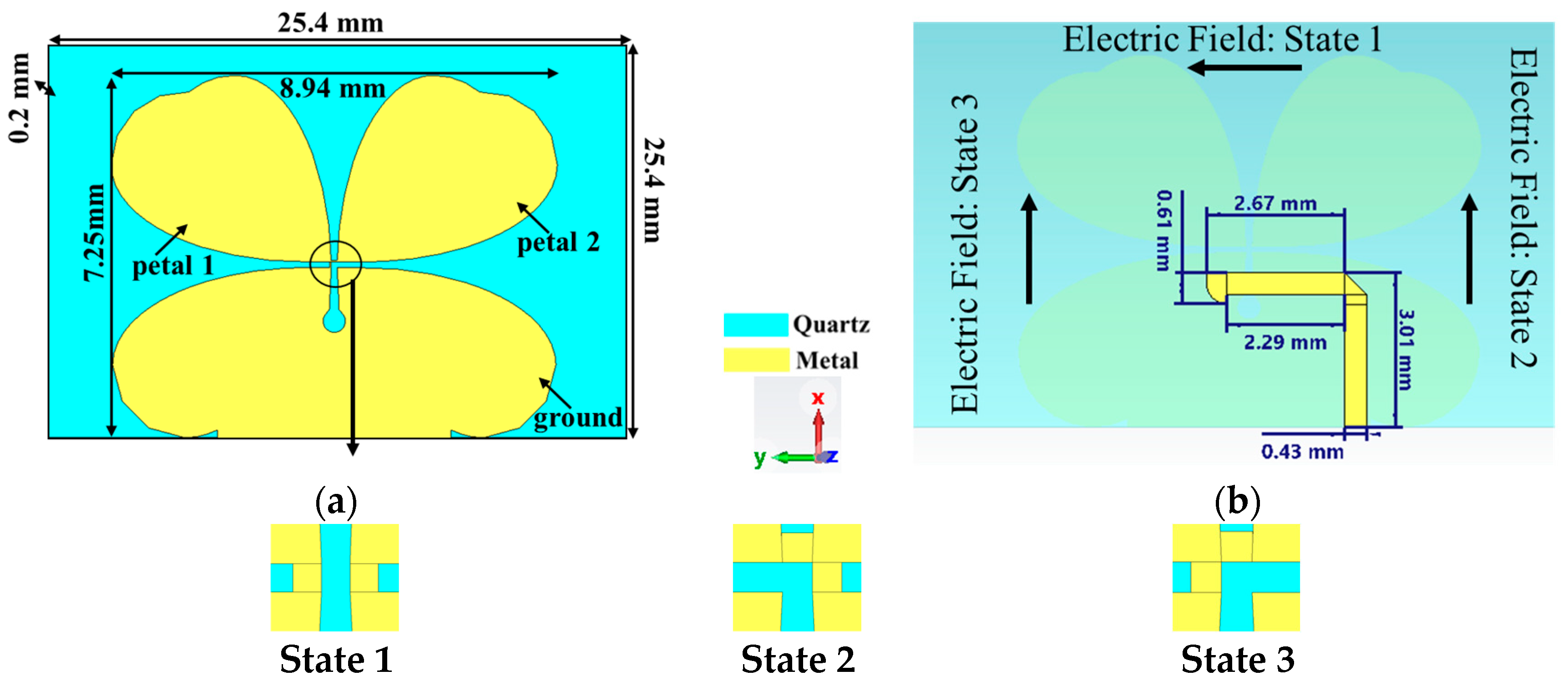
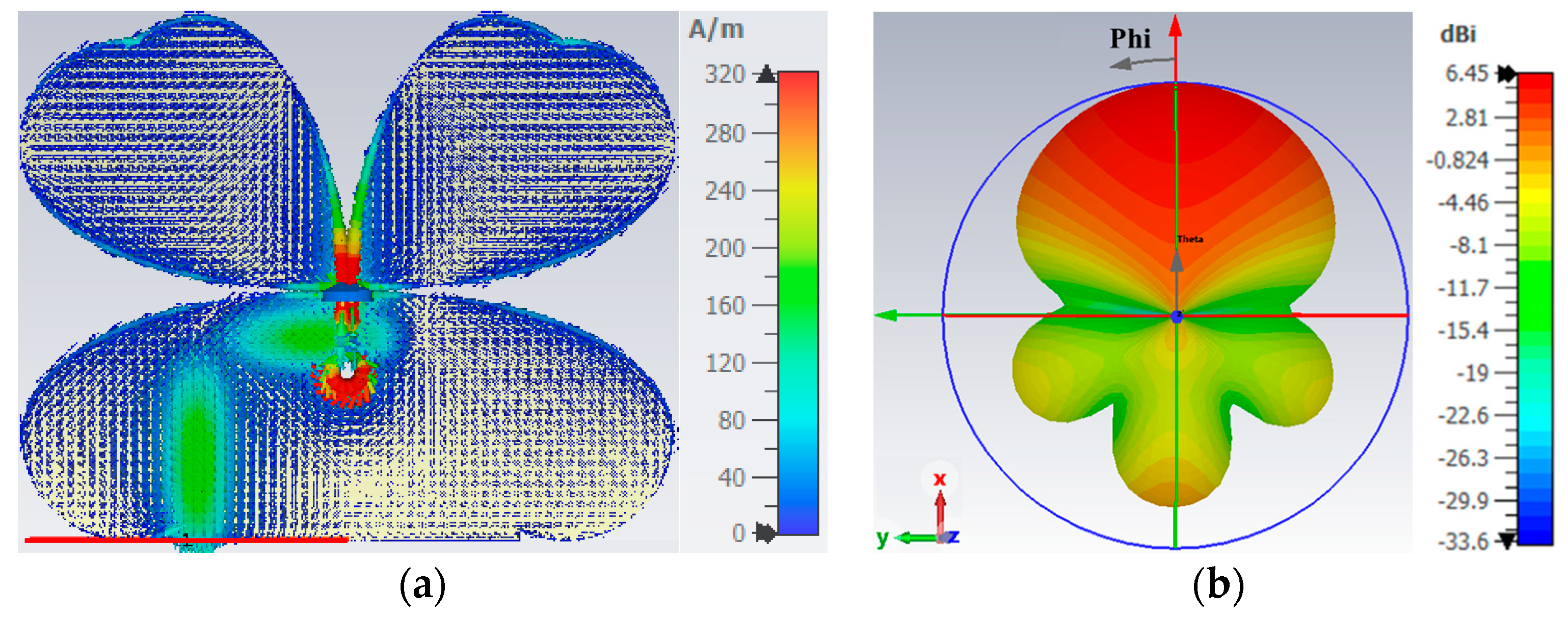
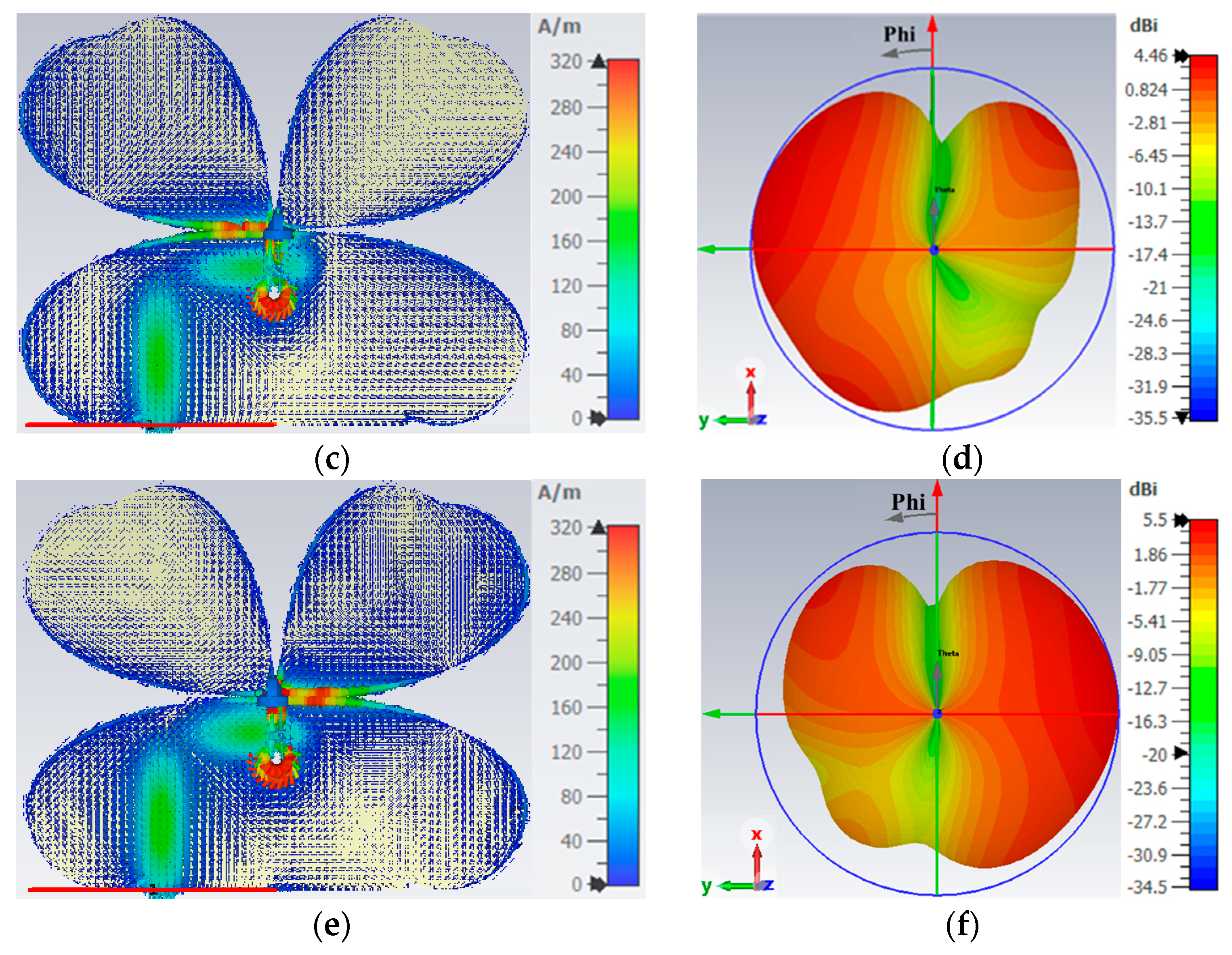
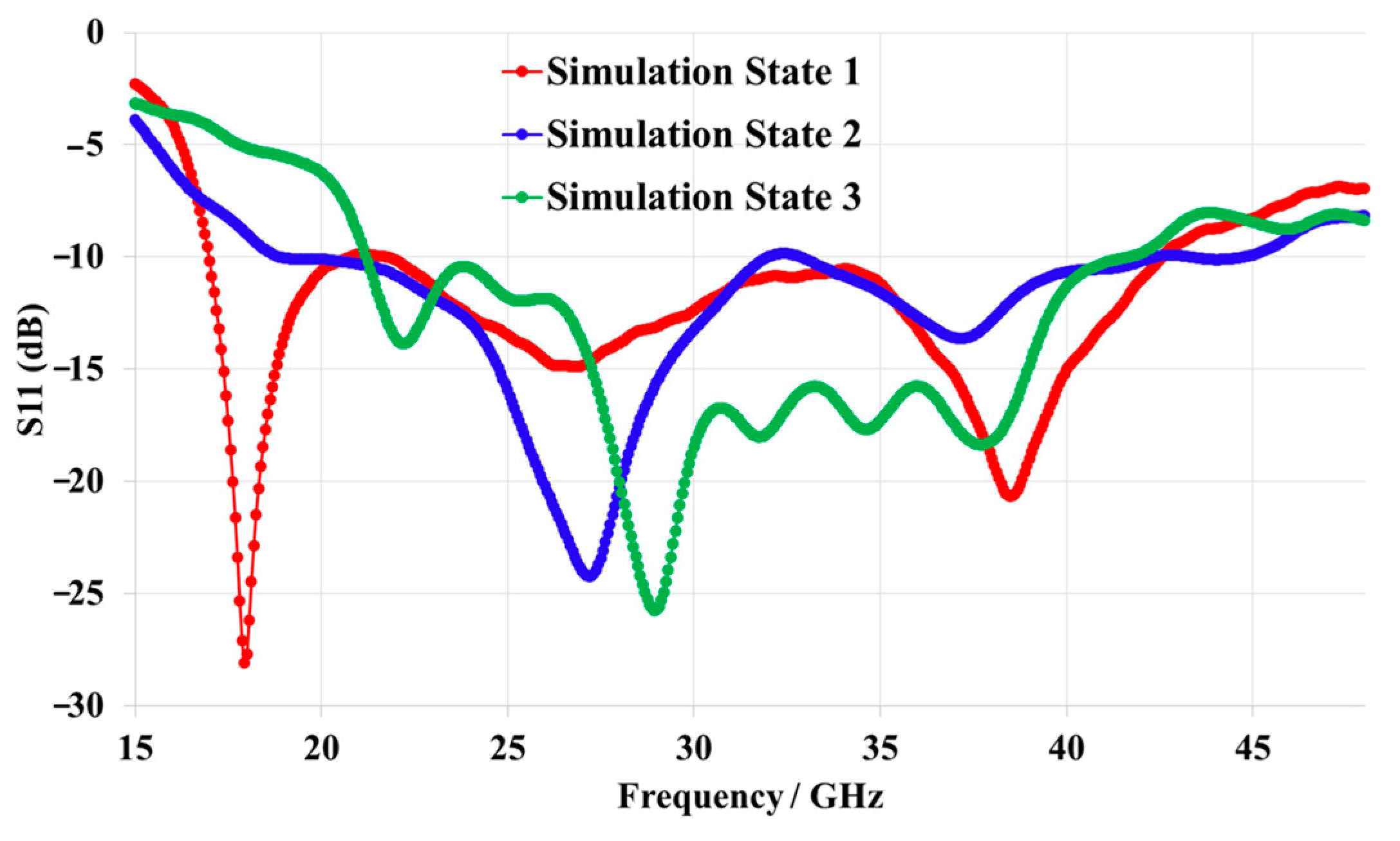

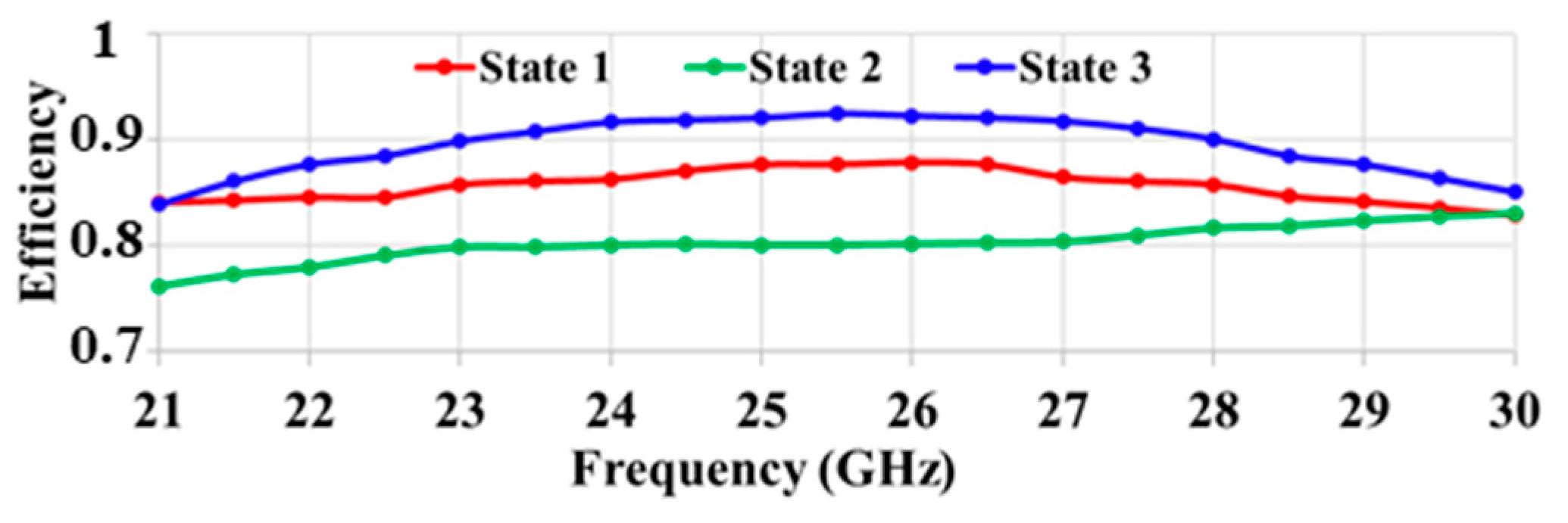
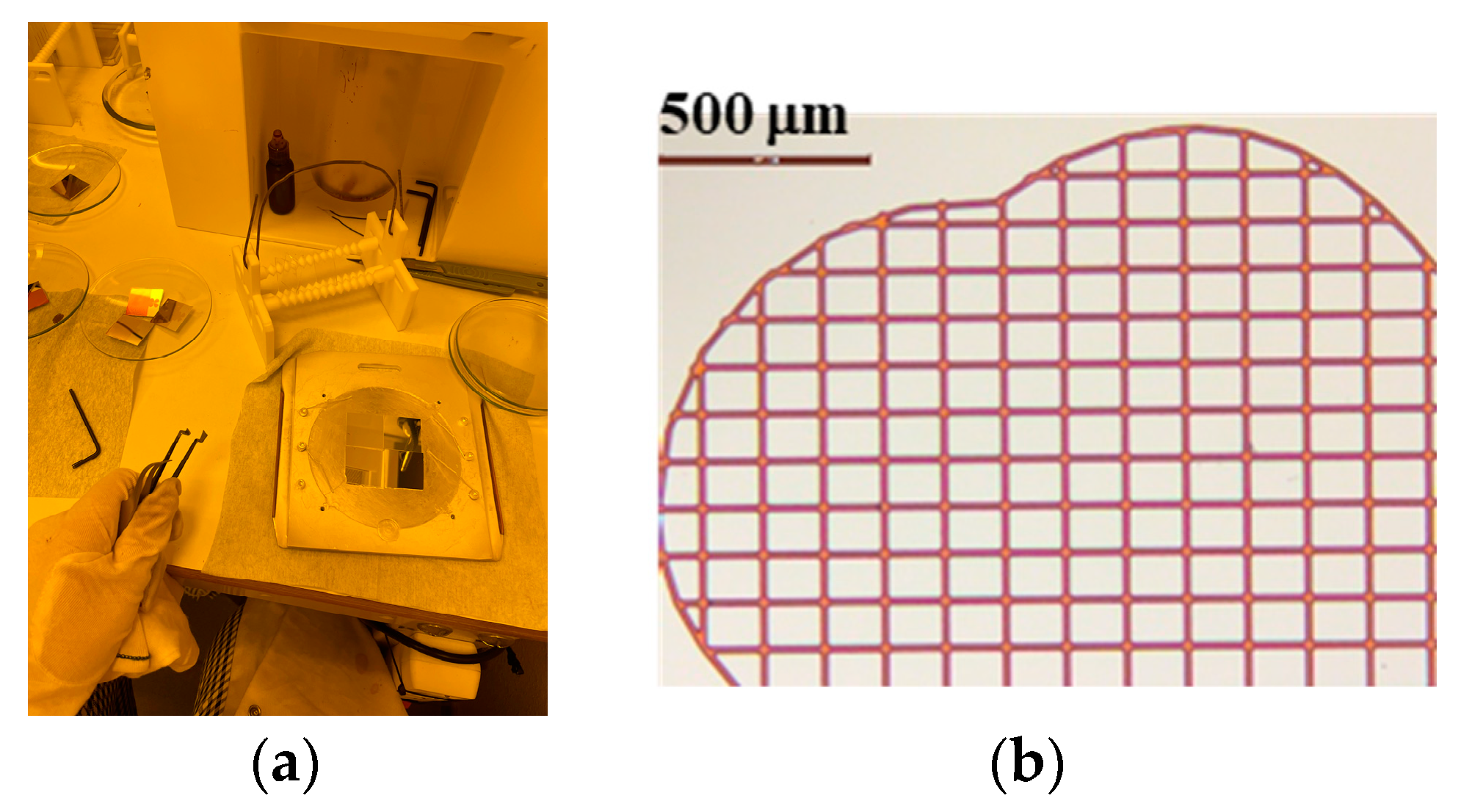
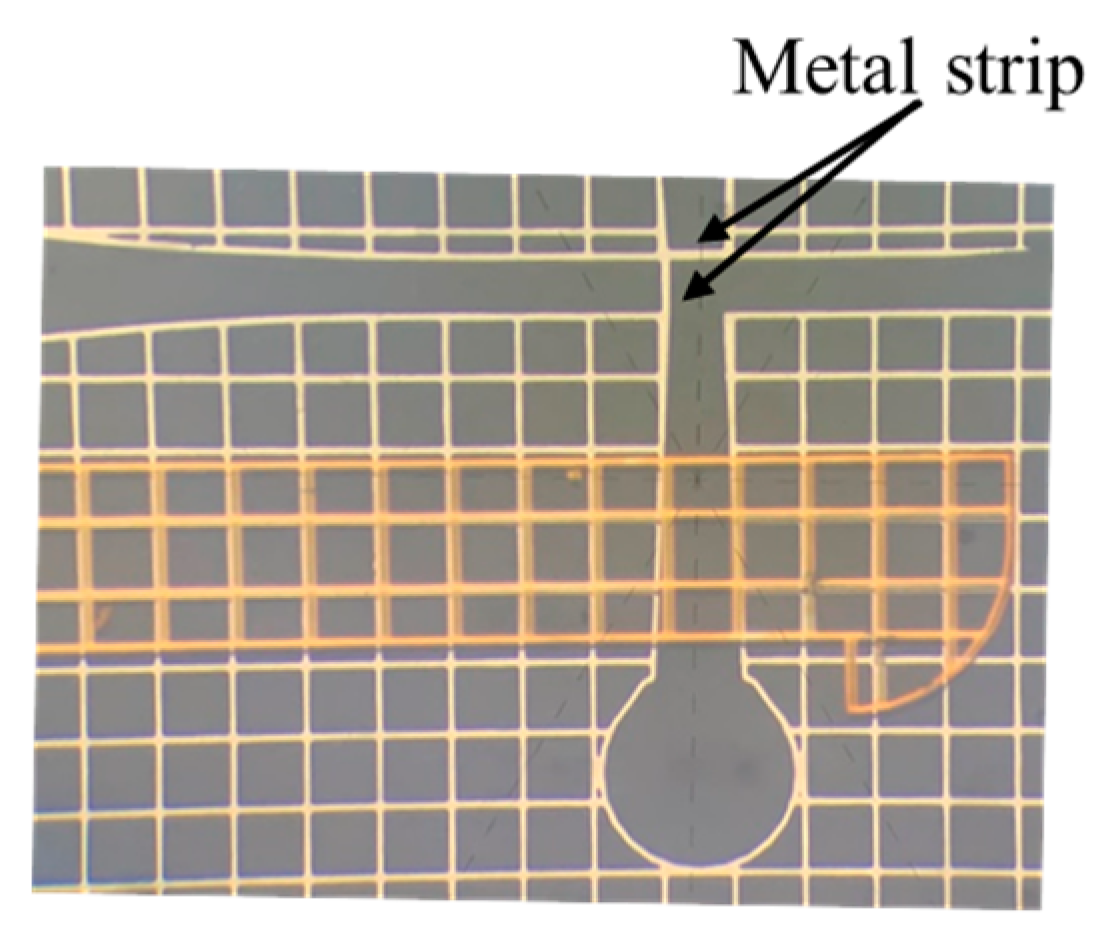

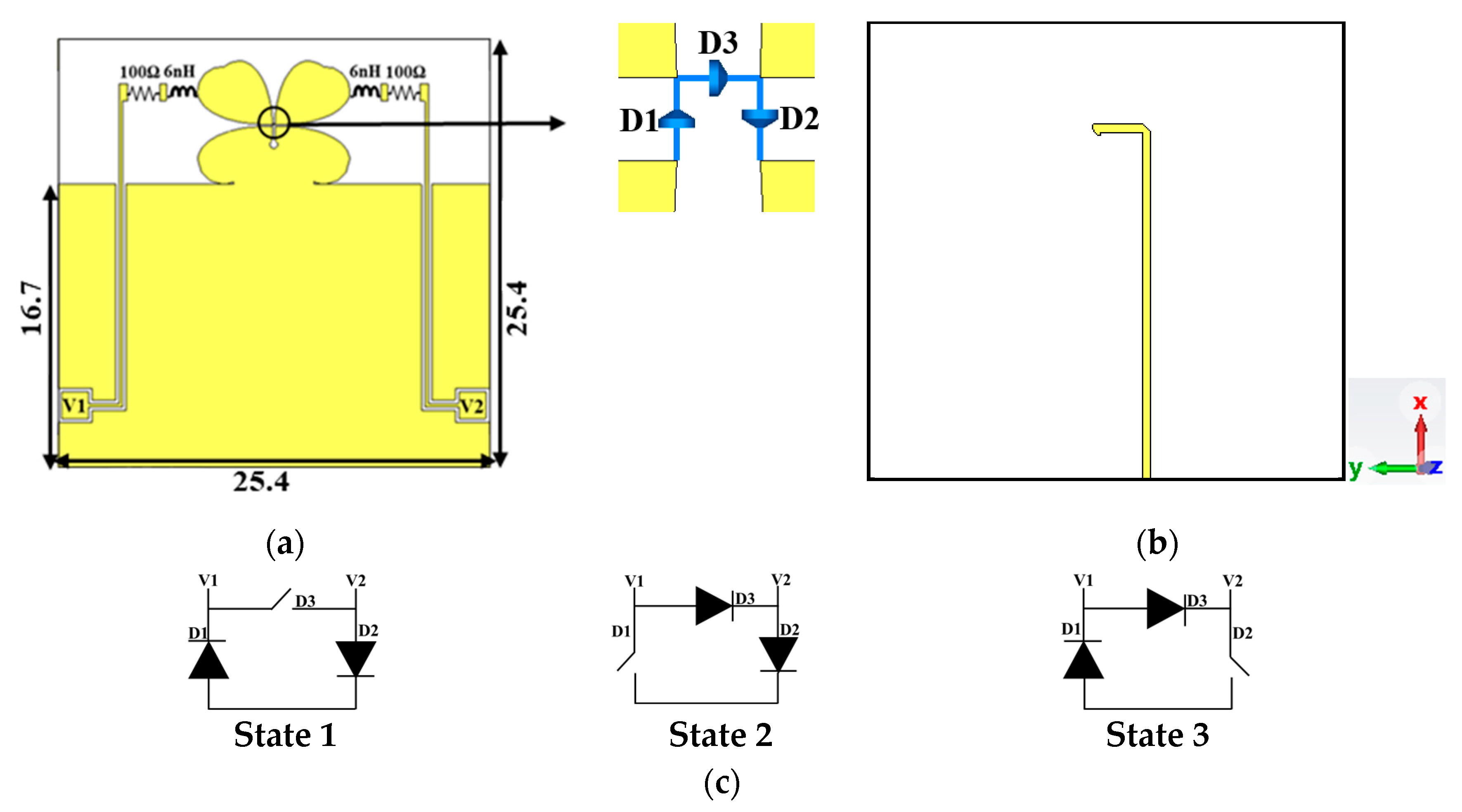
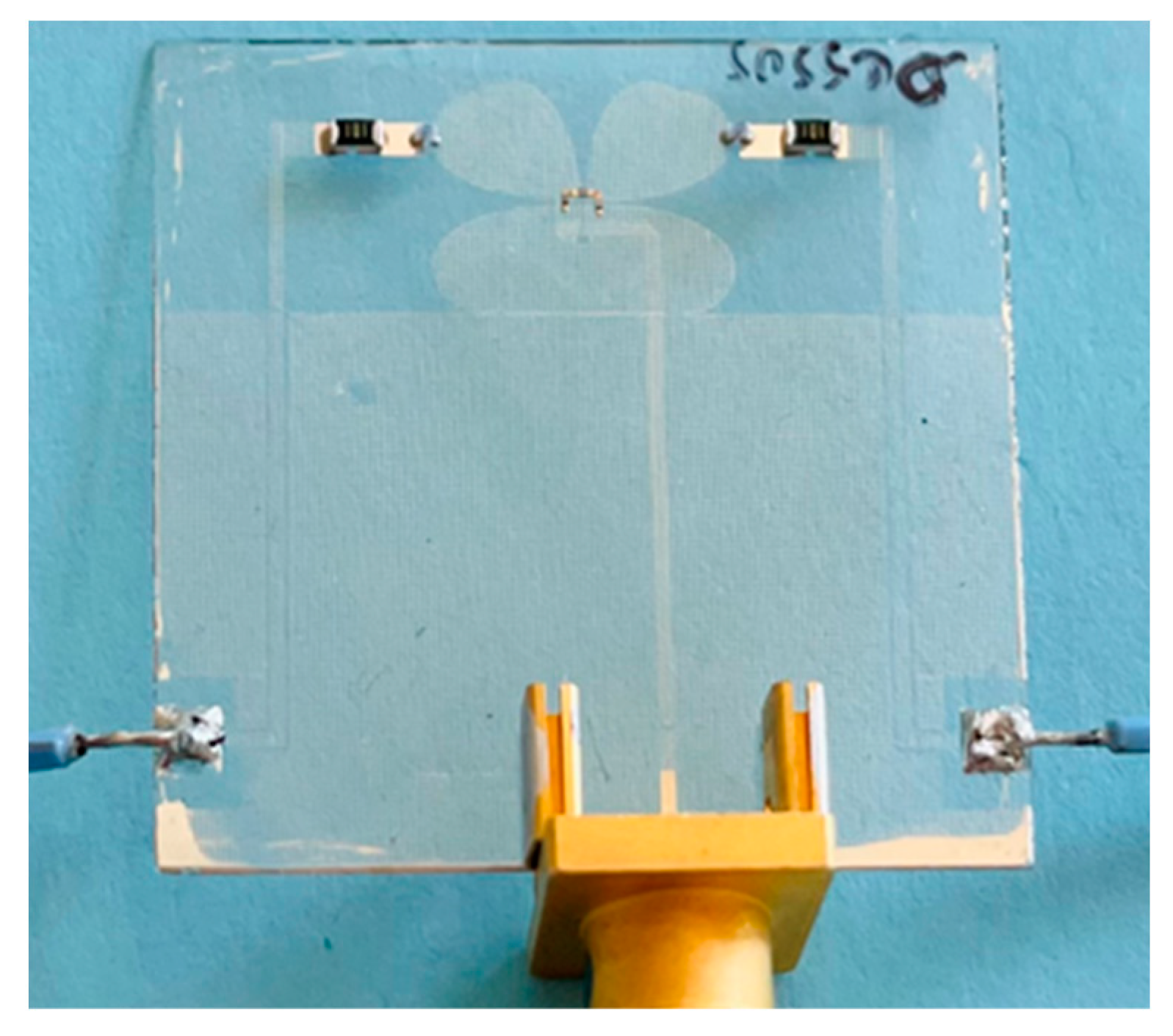
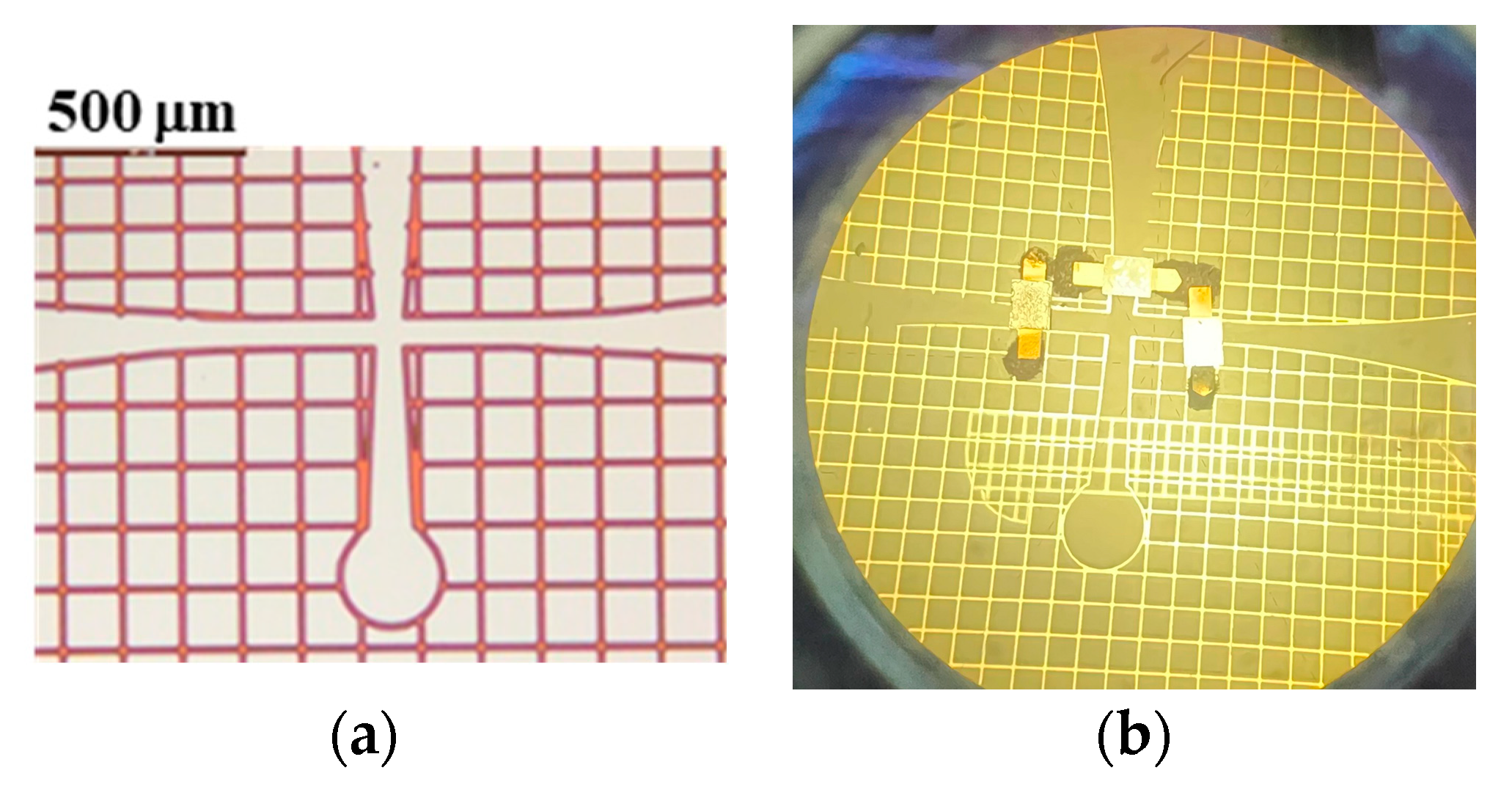




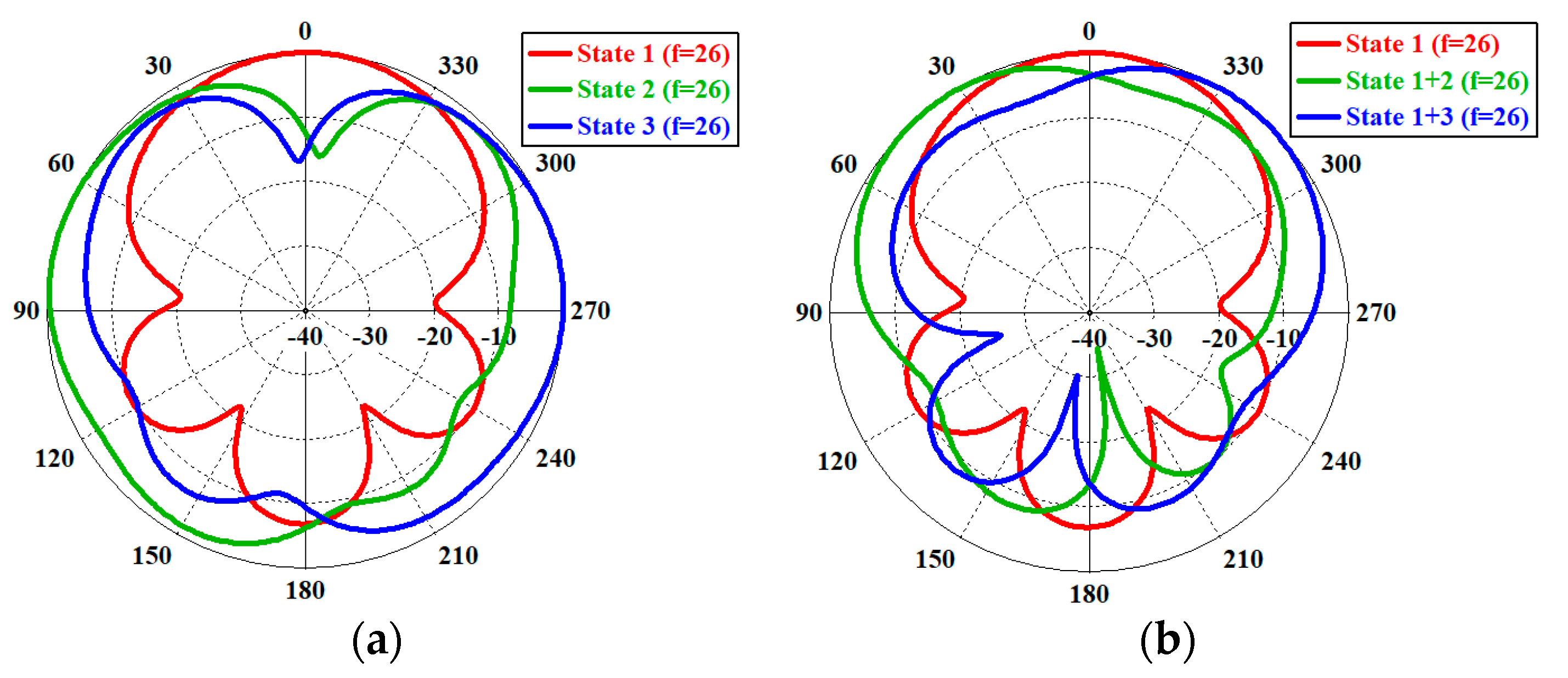
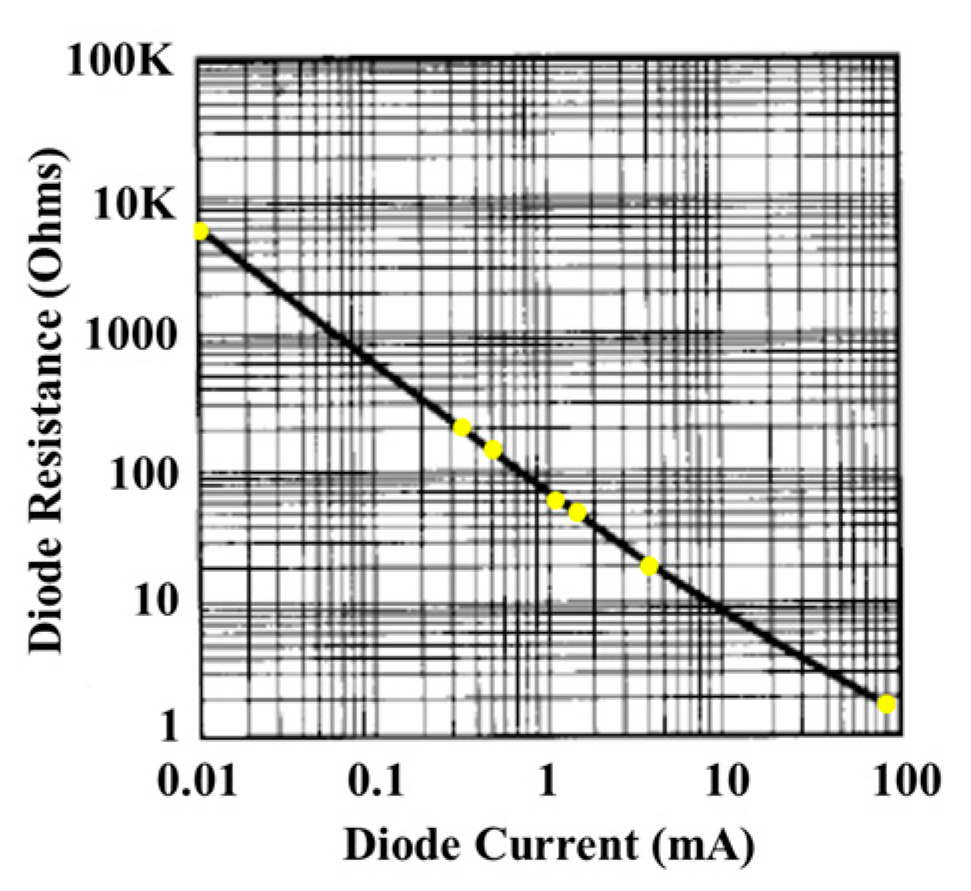
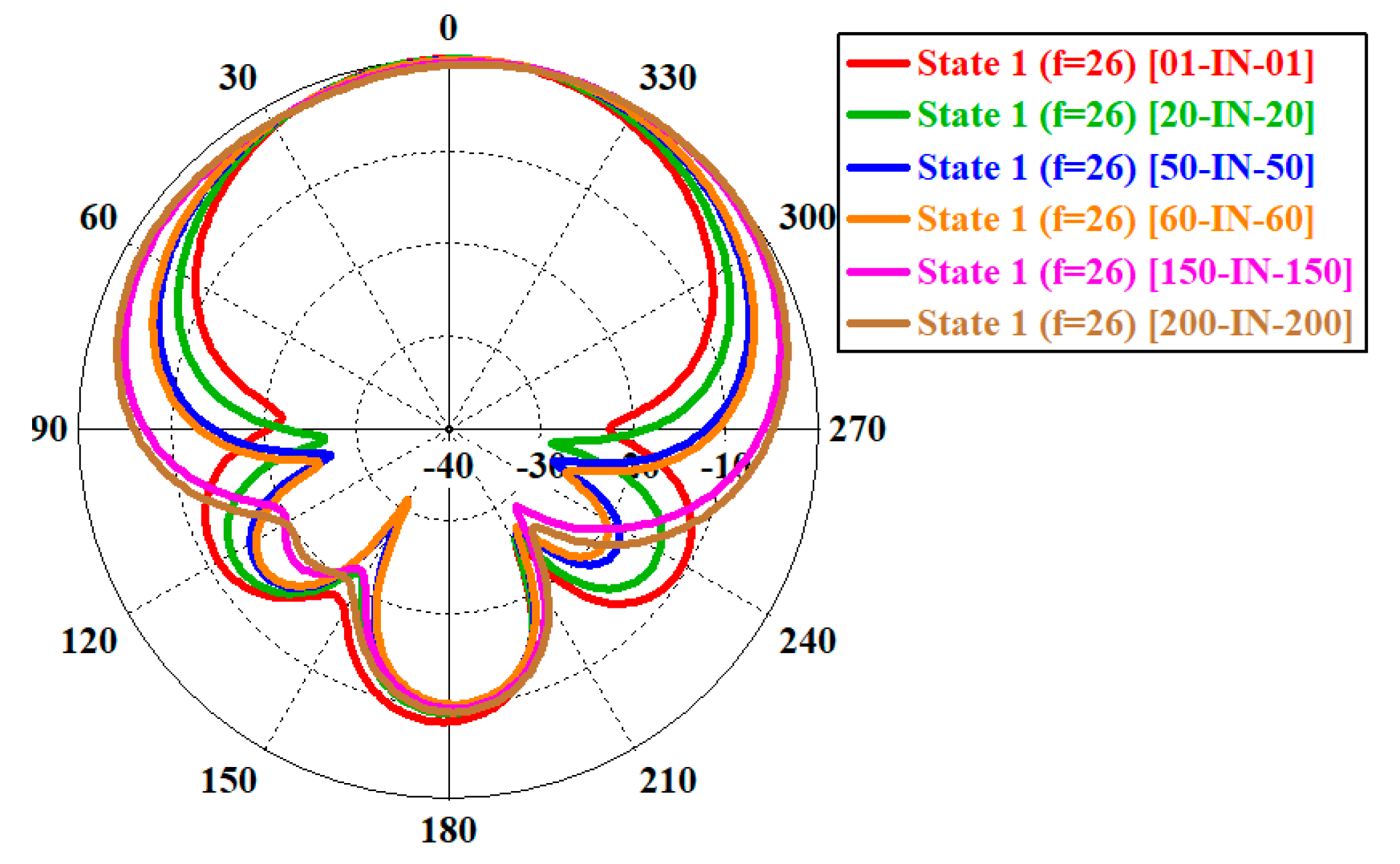
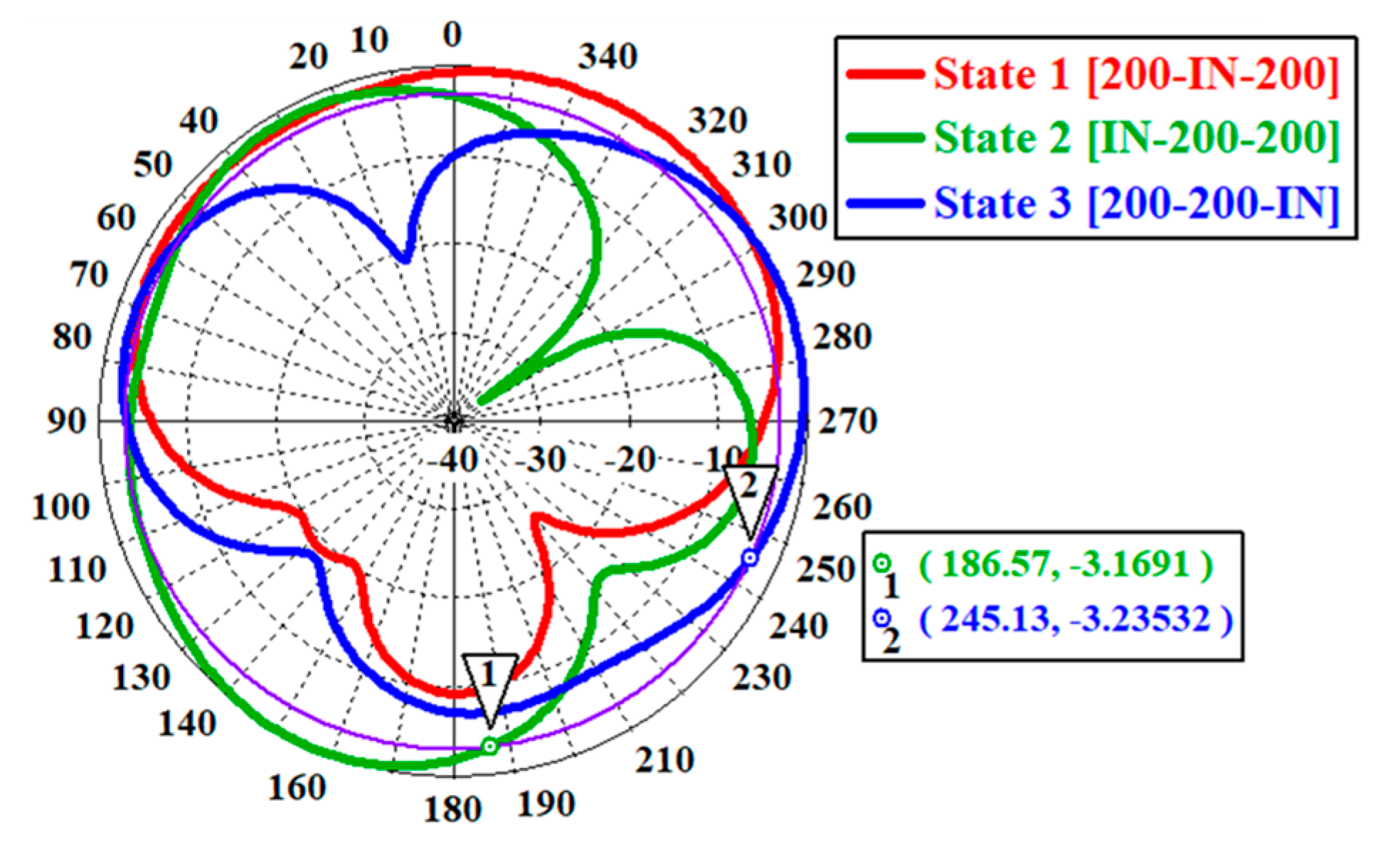
| States | V1 | V2 | ||
|---|---|---|---|---|
| State 1 | >0 | <0 | V1 > V2 | V1 = 2.9 V, V2 = −2.9 V |
| State 2 | <0 | <0 | V1 < V2 | V1 = −4.3 V, V2 = −2.9 V |
| State 3 | >0 | >0 | V1 < V2 | V1 = 2.9 V, V2 = 4.3V |
| State | D1 | D2 | D3 |
|---|---|---|---|
| State 1 | ON | ON | OFF |
| State 2 | OFF | ON | ON |
| State 3 | ON | OFF | ON |
| R = R2 = R3 | θ−3dB |
|---|---|
| 0 | 75 |
| 20 | 84 |
| 50 | 99 |
| 60 | 104 |
| 150 | 145 |
| 200 | 155 |
| Configuration | State | D1 | D2 | D3 | Beam Characteristic |
|---|---|---|---|---|---|
| 1 | State 1 | ON | ON | OFF | Broadside 0° |
| 2 | State 2 | OFF | ON | ON | +90° left |
| 3 | State 3 | ON | OFF | ON | −90° right |
| 4 | State 4 | OFF | OFF | OFF | large |
| 5 | State 1 + 2 | OFF | OFF | ON | +45° tilt |
| 6 | State 1 + 3 | OFF | ON | OFF | −45° tilt |
| 7 | State 2 + 3 | ON | OFF | OFF | Bidirectional ±90° |
| 8 | State 1 (R1-IN-R2) | Variable diode equivalent resistor R1 | Variable diode equivalent resistor R2 | OFF | Control of beamwidth around 0° |
| 9 | State 2 (IN-R3-R2) | OFF | Variable diode equivalent resistor R2 | Variable diode equivalent resistor R3 | Control of beamwidth around +90° |
| 10 | State 3 (R1-R3-IN) | Variable diode equivalent resistor R1 | OFF | Variable diode equivalent resistor R3 | Control of beamwidth around −90° |
| Ref. | Antenna | Method | RF Component | BW (%) | No. of States | Coverage Angle | Gain (dBi) |
|---|---|---|---|---|---|---|---|
| [6] | Patch | Parasitic tuning | 4 PIN diodes | 0.6 | 9 | 30° | 7 |
| [13] | Patch | Parasitic tuning | 3 PIN diodes | 23.5 | 2 | Conical/broadside | 6.9–8.2 |
| [15] | Patch | Parasitic tuning | 12 PIN diodes | 14.5 | 6 | 360° | 10 |
| [16] | Planar | Switchable stubs | 4 PIN diodes | 6.1 | 4 | 90° | 5 |
| [17] | Monopole | Multiple radiators | 4 PIN diodes | 34 | 4 | 90° | 2.8–3.7 |
| [23] | Patch | Multiple radiators | 16 PIN diodes | 2.6 | 16 | 22.5° | 4.4–6 |
| [24] | Dipole | Parasitic tuning | 16 PIN diodes | 8 | 5 | 45° | 5.2–6.5 |
| [32] | Triple Vivaldi | Non-transparent microstrip line | 3 PIN diode | 70 | 3 | 300° | 5.5 |
| [33] | Cone | Parasitic reflectors | Liquid metal | 45.5 | 4 | 30° | 6.7 |
| [34] | Tapered slot | Multiple radiators | 4 PIN diodes | 71 | 2 | 90° | 6.4 |
| [35] | Patch | Parasitic tuning | 6 PIN diodes | 29 | 12 | 30° | 8 |
| This work | Triple Vivaldi | Transparent microstrip line | 3 PIN diodes | 66.7 | 10 | 300° | 6.45 |
Disclaimer/Publisher’s Note: The statements, opinions and data contained in all publications are solely those of the individual author(s) and contributor(s) and not of MDPI and/or the editor(s). MDPI and/or the editor(s) disclaim responsibility for any injury to people or property resulting from any ideas, methods, instructions or products referred to in the content. |
© 2023 by the authors. Licensee MDPI, Basel, Switzerland. This article is an open access article distributed under the terms and conditions of the Creative Commons Attribution (CC BY) license (https://creativecommons.org/licenses/by/4.0/).
Share and Cite
Cherif, A.; Himdi, M.; Castel, X.; Simon, Q.; Dakhli, S.; Choubani, F. Radiation Beam Width and Beam Direction Electronic Control of Transparent and Compact Vivaldi Antennas. Appl. Sci. 2023, 13, 7878. https://doi.org/10.3390/app13137878
Cherif A, Himdi M, Castel X, Simon Q, Dakhli S, Choubani F. Radiation Beam Width and Beam Direction Electronic Control of Transparent and Compact Vivaldi Antennas. Applied Sciences. 2023; 13(13):7878. https://doi.org/10.3390/app13137878
Chicago/Turabian StyleCherif, Amani, Mohamed Himdi, Xavier Castel, Quentin Simon, Saber Dakhli, and Fethi Choubani. 2023. "Radiation Beam Width and Beam Direction Electronic Control of Transparent and Compact Vivaldi Antennas" Applied Sciences 13, no. 13: 7878. https://doi.org/10.3390/app13137878
APA StyleCherif, A., Himdi, M., Castel, X., Simon, Q., Dakhli, S., & Choubani, F. (2023). Radiation Beam Width and Beam Direction Electronic Control of Transparent and Compact Vivaldi Antennas. Applied Sciences, 13(13), 7878. https://doi.org/10.3390/app13137878








